 Climate change as a reality of nature: By the 18th century, literate people recognized that climate conditions described by Classical and Medieval authors were often different from those that they witnessed. Today we note that the canals of the low countries are no longer the reliable winter highways for skaters depicted by Peter Brueghel or described in Hans Brinker, or the Silver Skates. It is apparent that climate changes over time. As the science of geology arose, the attention of geologists was drawn to ancient climates for which no eye-witness accounts existed.
Climate change as a reality of nature: By the 18th century, literate people recognized that climate conditions described by Classical and Medieval authors were often different from those that they witnessed. Today we note that the canals of the low countries are no longer the reliable winter highways for skaters depicted by Peter Brueghel or described in Hans Brinker, or the Silver Skates. It is apparent that climate changes over time. As the science of geology arose, the attention of geologists was drawn to ancient climates for which no eye-witness accounts existed.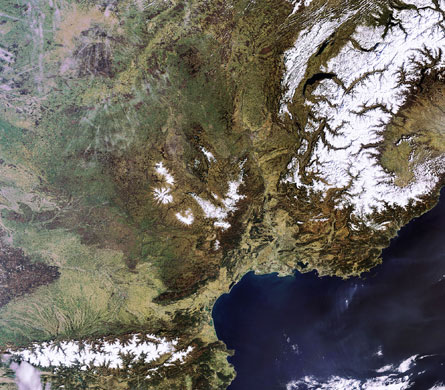 Louis Agassiz: (1807 - 1873) Swiss geologist, paleontologist, paleoclimatologist. Investigated reports of glacial erratics (glacier-transported boulders) in places where contemporary glaciers couldn't possibly transport them, such as the Jura Mts. of France and Switzerland. In 1840, published Etudes sur les glaciers (Study of Glaciers), proposing that the prehistoric Earth had experienced an ice age in which a continental glacier similar to that of Greenland had covered the Alps and had lapped against the Juras. As more information rolled in, it became clear that the the ice age glaciations had occurred at high elevations throughout the world and throughout high latitudes.
Louis Agassiz: (1807 - 1873) Swiss geologist, paleontologist, paleoclimatologist. Investigated reports of glacial erratics (glacier-transported boulders) in places where contemporary glaciers couldn't possibly transport them, such as the Jura Mts. of France and Switzerland. In 1840, published Etudes sur les glaciers (Study of Glaciers), proposing that the prehistoric Earth had experienced an ice age in which a continental glacier similar to that of Greenland had covered the Alps and had lapped against the Juras. As more information rolled in, it became clear that the the ice age glaciations had occurred at high elevations throughout the world and throughout high latitudes.
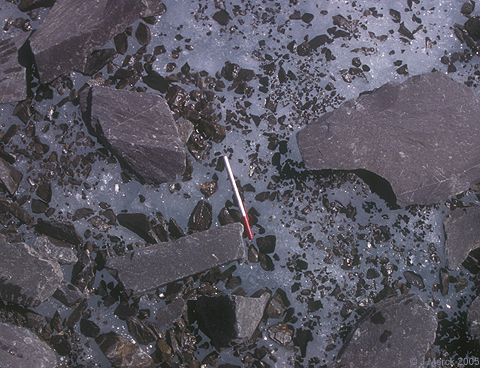 To know what kind of landforms led to this conclusion, one needs to understand the deposition of continental glaciers today:
To know what kind of landforms led to this conclusion, one needs to understand the deposition of continental glaciers today:
Land forms resulting from continental glaciers: Continental scale glaciation creates interesting opportunities for ice to interact with large volumes of sediment. Note: Glacial sediment takes three forms:
- Till: unsorted glacial sediment deposited directly by ice.
- Stratified drift: Glacial sediment that has been subjected to some degree of sorting by outwash streams.
- Erratics: Large boulders sitting out where they have no business.
Results include:
- Drumlin: Hills made of reshaped glacial till (unsorted glacial sediment deposited directly by ice).
- The steep end is on the side of the ice's approach
- The shallow end points in the direction of ice movement


- Kame [Scots"comb." Pronounced like English "came"]: Hills of stratified drift that form when a stream deposits sediment in a hole in the glacial ice
.
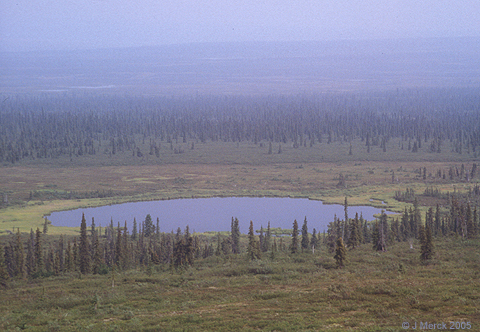

- Kettle lake: This is essentially the opposite of a kame. When a block of glacial ice is stranded by a retreating glacier, it prevents sediments from being deposited. When if finally melts, a depression is left that fills with water. Think of Minnesota - the land of 1000 lakes. these lakes are mostly kettles formed during the retreat of a continental ice sheet.


- Esker [Irish Eiscir - "ridge"]: Long sinuous ridge of stratified drift. Results from sediment deposited in the point bars of under-glacier stream.

- Permafrost in subsurface.
- Intense freeze-thaw cycles at surface
Resulting land-forms reflect interaction of regolith and ice:
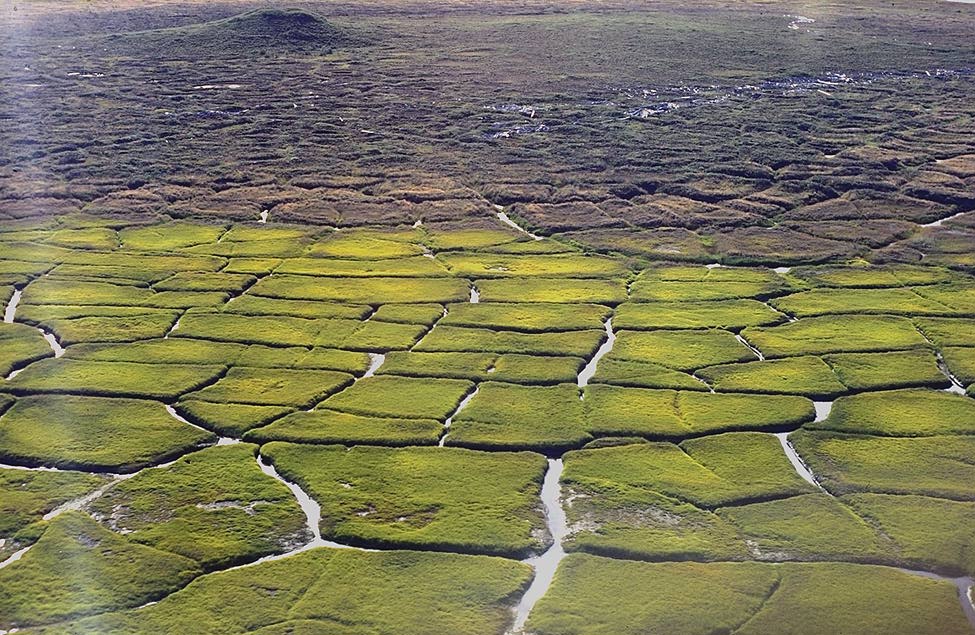

Pleistocene temperature and "proxy data": The first reliable thermometers went into use in Italy in the late 17th century. The first continuous records of daily temperature didn't begin until the early 19th century in England, so how do we know about ancient temperatures? We infer them indirectly through proxy data:
- Glacial landforms: document the presence of glaciers, but are a very blunt instrument. The problem with glaciers is that they don't record temperature precisely and that new ones bulldoze away the traces of older ones. As a result, ancient moraines and such only tell us so much about the history of glacial intervals.
Of course, the evaluation of glacial and periglacial landforms represented our first use of proxy data to assess climate change. This has subsequently been augmented by the other proxy records we ahve discussed, including:
- The oxygen and carbon stable isotope record
- The use of the distributions of climate-sensitive fossil organisms
- Bore-hole temperature data
- etc.
Ice ages:
 Putting this together reveals that climate over the last two million years has alternated between glacial and interglacial states, with atmospheric CO2 (plotted over the last 0.8 my, right) serving as a good general proxy for temperature.
Putting this together reveals that climate over the last two million years has alternated between glacial and interglacial states, with atmospheric CO2 (plotted over the last 0.8 my, right) serving as a good general proxy for temperature.
We note the following:
- Glacials: Intervals of intense and extensive continental glaciations, characterized by dramatic climate fluctuations and low average temperature.
- Interglacials: Interval of relatively constant warm climate with less continental glaciation.
- Ice-ages: Interval characterized by the prolonged alternation of glacials and interglacials. Earth has been in an ice-age for the last two million years, roughly.
Note: The end of each glacial interval is marked by an abrupt warming. As the precision of our measurements improves, we find this transition to be more and more abrupt - measurable on the order of decades. Transitions to glacial conditions are abrupt also, but somewhat more gradual.
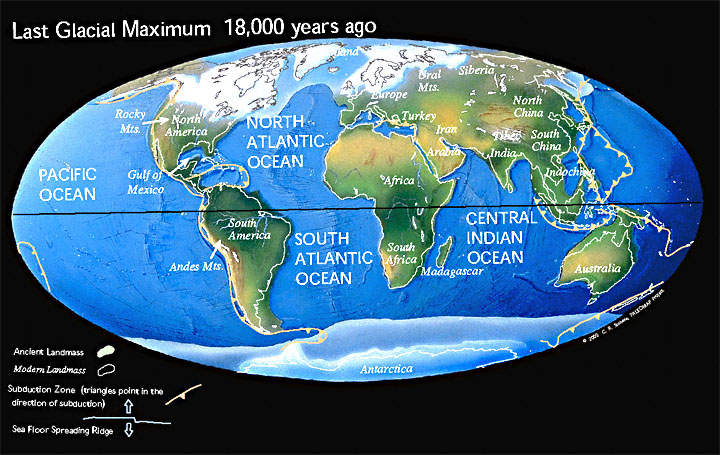 Condition 18,000 years ago during the last glacial maximum:
Condition 18,000 years ago during the last glacial maximum:
- Beringia - the land bridge across the Bering straites
- Australia, Tasmania, and New Guinea were one large land mass
- Many of the islands of Southeast Asia were part of the mainland.
How does climate shift between glacials and interglacials?
To address this we need to consider three factors:- Solar forcings: Changes in the amount of insolation that ultimately power climate change.
- The effects of continental positions: That determine whether there is any possibility for the formation of continental glaciers
- Feedback effects: That amplify the effects of solar forcings.
Solar forcings:
Milankovitch cycles: In the 1920s, the Yugoslavian meteorologist Milutin Milankovitch realized The Earth's movement through space is subject to three kinds of cycles:
- Orbital eccentricity: The orbit around the Sun is an ellipse that changes shape (becoming more and less circular) in a cycle of 100,000 years.
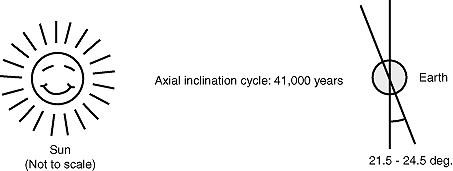
- Axial inclination: The axis of rotation is tilted. The angle of tilt varies from 21.5 deg. to 24.5 deg. in a cycle of 41,000.
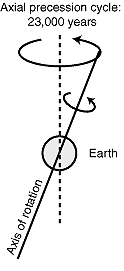
- Axial precession: The axis of rotation wobbles around an axis like that of a toy top. So, today the axis points toward Polaris, the north star, but 14,000 years ago, Vega was the north star. One full precessional wobble takes 23,000 years.
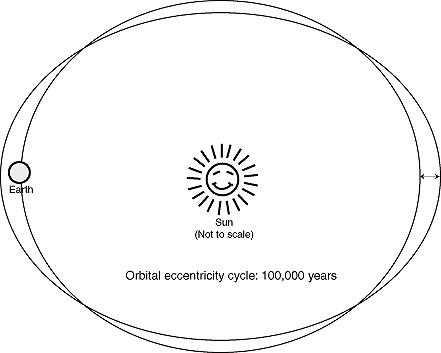
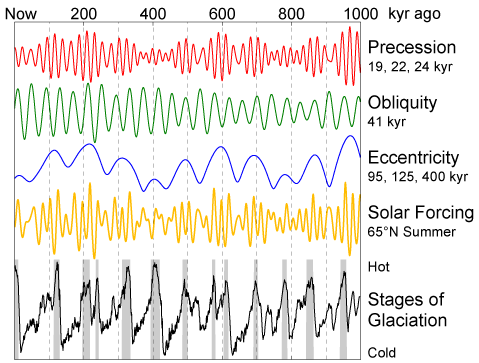 Solar forcing: The sum of the effects of these cycles gives the general tendency for glaciers to form. Note: Solar forcings are different at different latitudes and in different hemispheres. The graphic at right shows cumulative solar forcings for 65 deg. north, where most of Earth's land is concentrated.
Solar forcing: The sum of the effects of these cycles gives the general tendency for glaciers to form. Note: Solar forcings are different at different latitudes and in different hemispheres. The graphic at right shows cumulative solar forcings for 65 deg. north, where most of Earth's land is concentrated.
Solar forcings are irrelevant unless they favor mild summers in high latitudes: Each cycle influences the severity of winters to some degree, but what really matters is the mildness of summers. It snows hard in many places, and in polar regions, it always snows during winter. That's irrelevant. Glaciers only form in regions where at least some of the previous winter's snow survives the summer. Thus, when Milankovitch cycles favor mild summers, as when:
- orbital eccentricity is great,
- axial inclination is reduced,
- axial precession is such that summer comes when Earth is farthest from the sun,
 The effects of continental positions:
The effects of continental positions:
-
Ice-house world conditions prevail: Over deep time, Earth's pattern of ocean circulation has alternated between:
- Ice-house-world: Where ocean water circulation is driven by refrigeration and the formation of deep ocean water near the poles. Today's oceans, circulated by the formation of North Atlantic Deep Water (NADW) and Antarctic Bottom Water (ABW) is an ice-house world. (Do not confuse with "ice ages.")
- Greenhouse-world: Where ocean water circulation is driven by the density of warm hypersaline waters that form near the equator and spread northward. Dr. Holtz's precious Cretaceous was a greenhouse-world in which:
- Global currents could circle the world again and again without having to come near the poles
- The northward spread of warm equatorial bottom water spread equible climates into polar regions.
- There was neither continental ice, nor polar winter sea ice. It was an ice free world except for high mountain peaks.
- Quaternary Period:, The northern continents are close to the North Pole and Antarctica is at the South Pole.
- Carboniferous Period: The southern half of Pangea lay over the South Pole.
- Late Proterozoic Snowball-Earth episode: Not well understood but all indications are that the supercontinent of Rodinia blocked circumtropical circulation and extended into high latitudes in both hemispheres. Remember, this was when continental glaciers extended into the tropics, and the majority of the ocean was covered in sea ice.
Large land masses (snow-catchers) exist in high latitudes Consider past ice ages:
The process with feedback effects:
If the above conditions are met, then the interaction of the Milankovitch cycles can initiate a glaciation. That is only the beginning. The factors that cause ice ages form a positive feedback loop. In the following schematics, keep track of these variables:
- Incoming solar radiation: Controlled by Milankovitch cycles or (possibly) changes in the sun's actual output.
- Albedo: The Earth's reflectivity. Ice's albedo is very high. That of ocean water is low. The more sunlight gets reflected into space, the cooler the climate.
- Greenhouse gas concentration: Especially CO2. These are consistently erupted from volcanoes, regardless of the climate.
- CO2 weathering reactions: Atmospheric CO2 (in a series of steps) interacts with rocks in weathering reactions, yielding CaCO3. The CaCO3 typically ends up in the oceans, where it can be precipitated as chemical sediments. By this means, these take atmospheric carbon and move it into the solid Earth.
Snowball Earth in a Nutshell: We start with the example of the most extreme, but also the simplest example, the Snowball Earth episode of the later Proterozoic in which the supercontinent Rodinia was gripped by the greatest known glaciations. Note: The Proterozic world was simpler, because there was no significant biosphere to move carbon around.
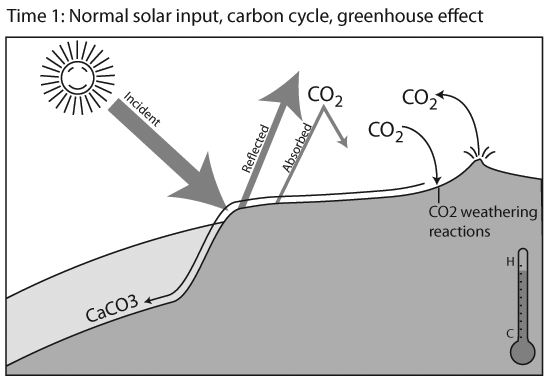
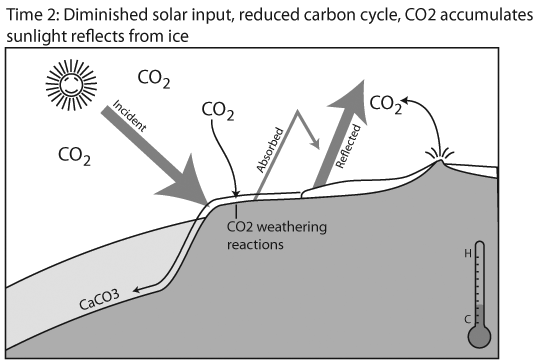
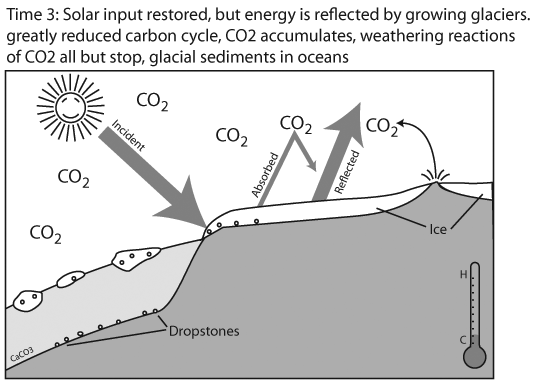
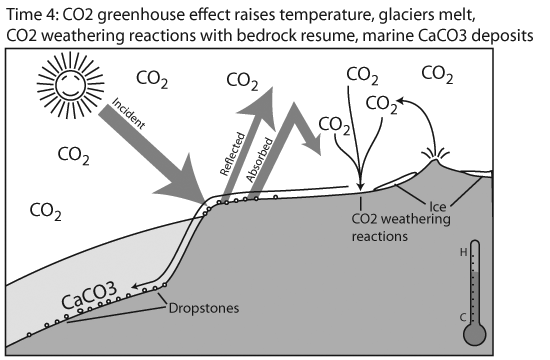
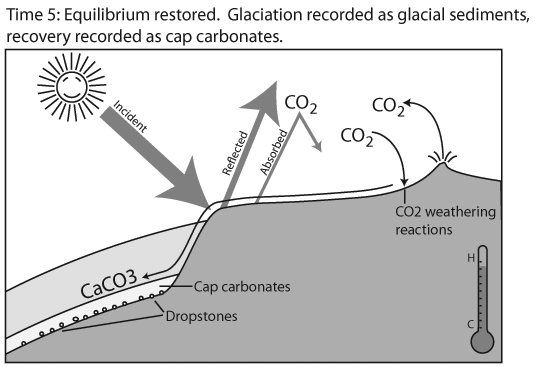
The end? Only until solar forcing upsets the equilibrium again.
How long does it take? From the time that the ice starts to melt and CO2 weathering reactions can resume, it takes up to 150,000 years for the atmosphere to return to equilibrium. Why doesn't the CO2 just dissolve in the oceans? Much of it does, but to get it into the deep oceans requires passing it through the small oceanic "windows" where surface waters sink into the depths. (Today = NADW and ABW.) That also takes millenia.
the warming phase:
We have already seen examples of global warming - the recoveries at the end of glacial intervals. These tend to happen rapidly. More recent ice-ages (Carboniferous and Quaternary) have been less extreme than the Snowball Earth episode, so that the restoration of strong incoming solar energy in summer has been enough to trigger deglaciations. Just as cooling triggers a positive feedback loop over a short time scale, so does warming:
- Incoming sunlight warms summer hemisphere causing ice to begin to melt.
- Warming oceans can hold less CO2, so this comes out of solution, increasing atmospheric greenhouse effect.
- On warming continents, decomposition of (previously frozen) plant material releases more CO2.
We see that just as the albedo of growing ice sheets amplified cooling through solar forcing, the release of CO2 amplifies warming through solar forcing.
Caveat: Yes, we just said that warming exposes bedrock that drives CO2 weathering reactions that remove CO2 from the atmosphere. Now we're saying that warming adds CO2. WTF? The difference is the time scales involved. The positive feedback processes described above work on an order to decades. The weathering reactions work on the order of tens of millenia. Weathering reactions win in the end, but not before the positive feedback elements have had their day.

Fine-tuning cycles within cycles:
Heinrich events: Within the ~100,000 year glacial-interglacial cycle hide smaller, more subtle cycles. Sedimentologists note that during the Quaternary, we see occasional deep ocean sediments full of glacial dropstones, a sign that during an interval of less than 1000 years, vast flotillas of icebergs detached from glaciers and spread out to melt in the northern oceans. Heinrich events are occur on average every 7000 years. Cause is debated, but may be connected with complex chains of events where:
- Warm northern hemisphere currents are deflected southward by the injection of fresh meltwater...
- causing northern oceans to cool and adjacent glaciers to expand...
- causing the southern oceans to warm...
- causing antarctic ice to melt...
- raising sea-level globally
- lifting the edges of northern glaciers off their bedrock, causing profusion of icebergs.
Climate change on larger Time-Scales: The Plate-Tectonics has its say
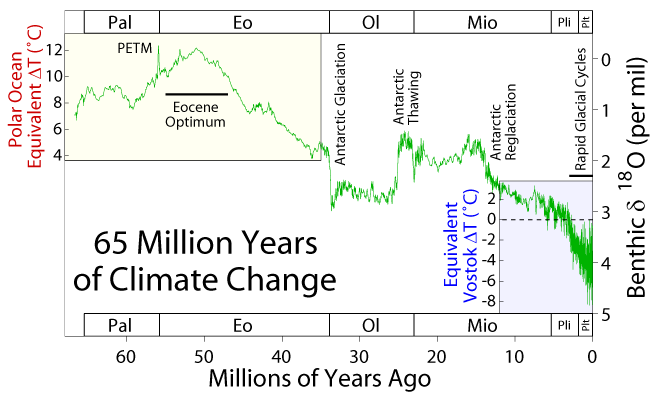 When we consider climate change in the deeper past, we see larger-scale patterns in which global warming and cooling is effected directly by the moving continents. This works in two major ways:
When we consider climate change in the deeper past, we see larger-scale patterns in which global warming and cooling is effected directly by the moving continents. This works in two major ways:
- Weathering reaction frenzy: Can we have a cooling event without warming up first? Remember CO2 weathering reactions? Simply expose a huge amount of unweathered bedrock to the atmosphere, and CO2 will be drawn out by weathering reactions. The resulting reduction in greenhouse gasses can cause global cooling directly. In fact, the collision of India and Eurasia (last 10 my), with the elevation of the bare bedrock of the Himalayas and Tibetan Plateau has been suggested as a contributor to the Neogene ice-house world. This correlates well with previous great ice-ages that were characterized by supercontinents with enormous interior orogenies. Recovery would occur when erosion rates eventually diminished and atmospheric CO2 returned to equilibrium levels.
- Moving continents redirect ocean currents: The graph at right tracks the shift from the Cretaceous greenhouse world to the Neogene ice-house world. This happened in fits and starts, but major changes coincide with the opening and closing of seaways.
- Eocene: Climate cools from its high-point as Australia and South America begin to break away from Antarctica, allowing the beginnings of circum-antarctic circulation and ice-house conditions.
- Miocene onward: The docking of Africa with Eurasia and the formation of the Isthmus of Panama closes off the circum-equatorial current. Ocean water now must absolutely visit polar regions. Extreme ice-house prevails.
 Can we have a warming event without first cooling the Earth off?
Can we have a warming event without first cooling the Earth off?
In fact, it's happened. The Paleocene-Eocene Thermal Maximum (PETM): 55 m.a., the boundary of the Paleocene and Eocene Epochs of the Paleogene was marked by proxy data suggesting a rapid warming of 5-6 deg. C within 20,000 years. This was caused by the sudden appearance in the atmosphere of a high concentration of CO2. Over the following 150,000 years, temperatures returned to their previous (greenhouse) equilibrium. This event is of great interest because it strongly resembles the anticipated effects of contemporary anthropogenic global warming. The big question: Where did the "extra" CO2 that drove the PETM come from? Two possibilities:
- Methyl hydrates: Solid solutions of ice and methane that form in sediments of the deep oceans under great pressure. Methane (CH4) is much more powerful than CO2 as a greenhouse gas. It is quickly broken down into CO2.
- CO2 released by unusual volcanic activity.
Extinction event: The PETM coincided with a minor extinction event, and with the origin of several modern mammal groups (even and odd-toed ungulates, carnivorans.) For foraminiferans, it was a true disaster. The PETM is quite visible in the core sample at right. The change in color coincides with a global extinction of foraminiferans.
Why were they extinguished? Arguably, the acidification of the oceans, as large amounts of CO2 reacted with water to form carbonic acid.
The PETM is a good general model for the carbon emissions going on now. It is, of course, now part of a cycle. Such one off events can be especially scary. E.G. the volcano-global-warming driven Permian-Triassic extinction event.
The future: Had the industrial revolution not occurred, this would still be a complex topic. What is known is that:
- The warmest period of the Holocene Epoch (the last 10,000 years) occurred roughly 6,000 years ago. At this point Earth had its highest recent sea levels "Holocene highstand". Since then, Earth has cooled and sea levels dropped slightly.
- Projections of solar forcing suggest a close approach to the point at which continental ice might start growing in 3000 years. If glaciers don't grow then, the stronger solar forcing is expected in 50,000 years.
- But the industrial revolution has returned to the atmosphere CO2 that was locked up over millions of years during the Late Paleozoic. The predictable result is an increased greenhouse effect. The extent of future global warming will depend on exactly how much CO2 is ultimately released. The consumption of all accessible fossil fuels could yield a warming event on the scale of the PETM. Instead, extrapolating from current trends in CO2 emissions, climatologists predict a 3-5 deg. C increase in global temperature by 2100. That's at least half the increase that the world experienced at the end of the last glacial! Such a warming will overwhelm any solar forcing and "postpone" the next ice age for at least 150,000 years, long enough for weathering reactions to get rid of excess CO2.

